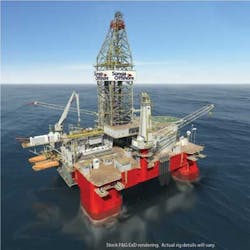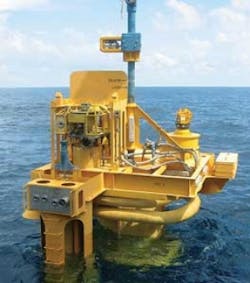Optimizing subsea production using multiple-application re-injection technology
Daniele Petrone
Cameron
Reservoir conditions seldom evolve as originally predicted, and the need to intervene on subsea hardware during field life is almost guaranteed. With this uncertainty, operators are challenged to:
- Increase the net present value of assets
- Reduce HSE risk
- Increase incremental recovery from assets
- Reduce reservoir risk
- Reduce capex
- Lower opex
- Maintain a flexible production strategy
- Allow for low-cost maintenance intervention.
These seemingly diverging challenges begin to converge when the range of production optimization opportunities is realized by installing any process on any well. This is achieved by using the Multiple Application Re-injection System (MARS), a device that establishes a retrofit access port. MARS is the equivalent of a USB port for a subsea wellhead. Production optimization, therefore, no longer requires major field shutdowns or infrastructure decommissioning; access is simply achieved via MARS.
Multiple applications
MARS is a production optimization technology that establishes the wellhead as the unit of production, enabling processing equipment to be mounted directly onto production trees. By introducing a coaxial flow path insert into the tree, well fluids are directed externally to a flow loop that houses a processing technology. Flow is returned to the wellhead and back into the existing flowline infrastructure.
Processing hardware is installed between the existing isolation barriers and eliminates the need for expensive, high-risk well intervention, field shutdown, or flowline decommissioning, while reducing production losses.
The technologies and the range of possible solutions are evolving. The number of existing or emerging processing technologies that can be fitted onto any wellhead with minimal risk include:
- Multi-phase pumping
- Multi-phase metering
- Fluid sampling
- Chemical injection and well stimulation
- Sand management
- Separation
- Bulk water management and re-injection
- Raw seawater injection
- Pressure boosting
- Dehydration
- High-integrity pressure protection systems.
Multiple configurations
The MARS-friendly christmas tree (MFXT) specification allows operators to define interface requirements, reduce capex, and delay opex, while providing future flexibility to increase production and ultimate recovery. Several operators in the North Sea and West Africa have specified MFXT.
MARS initially was developed and applied to extreme applications and environment, i.e., deepwater subsea. The system has been hyperbarically qualified to 9,843 ft (3,000 m) and installed to 5,577 ft (1,700 m). In 2012, Cameron will install its first topside version of the technology offshore Norway, where it is being used as a low-cost method for retrofitting a multi-phase meter.
The strategic drivers on platforms are very similar to subsea – low-risk, low-cost plug-and-play reservoir optimization and metering, which can be installed easily without the need for hot-work permits and shut-down requirements.
On platform wellheads, the "MARS via the treecap" method is adopted. The principle is similar to the subsea variant, but the co-axial flow path is located in the tree bore, as opposed to the retrievable choke body.
Reservoir stimulation
One of the biggest production issues is managing water-flooded fields, of which scale management potentially is the most significant. Strategies to address scale vary across the industry. When a low-sulfate water (LSW) treatment plant is located on a topside facility, it greatly reduces, but does not eliminate, the barium scaling tendency within the reservoir. Thus, a means of treating the wells directly has to be considered. Additionally, the LSW plant impacts topside power and size requirements, as well as initial project capex, with ongoing plant maintenance adding to opex costs.
Scale treatment is planned to be carried out on an as-required basis, which can be done by using either a rig or intervention vessel to squeeze the well directly. Alternatively, a direct squeeze from the production facility can be achieved by using an existing test or production flowline. Depending on the severity of the scaling issue, the system architecture and the frequency of the operation, these options can have significant opex and production impact.
If MARS is deployed from a suitable ROV support vessel or field vessel, once the MARS choke is installed, only production from the well being treated is affected, thereby reducing the production impact.
In 2008, Shell UK installed the first MARS-based subsea well intervention system to carry out scale-squeeze operations on a North Sea well. To enable optimum production from existing subsea wells, Shell required chemical (scale) squeeze approximately every six months. By upgrading the subsea trees to accept MARS technology, Shell was able to optimize its scale-squeeze operations.
This technology delivered to the operator a permanent low-risk access point to both the reservoir and pipeline via the tree. In doing so, MARS achieved:
- Elimination of required rigs or divers
- Reduction in production shutdown time
- Reduction of installation, mob, and demobilization times
- Use of ROV operations
- Reduction in overall vessel costs
- Treatment of wells more frequently (larger weather window)
- Treatment of multiple wells in a single campaign
- Reduction in environmental risk.
To date, these systems have been retrofitted subsea onto existing hardware in Bittern field. Additional systems will be installed onto the next operational trees during systems integration testing. In addition to Bittern field, Shell has adopted the well treatment system for Pierce field. This approach, which involves servicing subsea wells on an individual basis, has proved to be cost-effective in terms of opex and in reducing production downtime caused by multi-well treatment strategies.
The philosophy of viewing the well as a single unit of production is gaining acceptance. Tackling production issues on a per-well basis is seen as a more efficient and cost-effective approach than alternative field-based solutions.
In December 2009, an operator in West Africa successfully deployed MARS for scale treatment operations in a field offshore Angola in 2,625 ft (800 m) water depth. Although there were plans for scale treatment, the emergence of MARS technology allowed the operator to re-evaluate its infrastructure development strategy. Here, 14 subsea trees were retrofitted with MARS chokes. The trees will access the chokes via MARS intervention universal work platform (UWP) systems from an available vessel.
This choice of well intervention for scale-squeeze operations allows the operator to mitigate key operational risks, including:
- No pigging, eliminating the risk of stuck pigs
- All production and test lines remain in service
- Reduced risk of well damage
- Test line is only used for cleanup
- Potential to use a field vessel
- Can be done when required (i.e., not just when a vessel is available)
- Only lost production is from the well being squeezed.
The MARS UWP incorporates all of the required well control systems and vessel drive-off protection provided by the breakaway manifold system. In addition to the MARS subsea scope of supply, Cameron also supplied the topside scope, which included the delivery system for the chemicals and vessel overboarding equipment.
To maximize the efficiency of this method of managing scale in subsea wells, MARS modified chokes now are being considered for greenfield and new well developments where the choke is fitted to the tree as part of the tree system integration testing, removing the need for retrofit operations and reducing the overall cost of each operation by approximately 8 to 12 hours.
Several operators in the North Sea and other deepwater provinces view MARS as an efficient, cost-effective way to gain access to subsea wells for well stimulation operations. Applications for this technology are not limited to well intervention. The range of possible solutions enabled by MARS is evolving.
Multi-phase pumping
In December 2007, an operator in the Gulf of Mexico commissioned two 1.5-MW subsea multiphase pumps (SMPs) on a major project. This operation yielded several key industry milestones:
- First SMP in the Gulf of Mexico
- First SMP used by this operator
- Deepest SMP installation to date: 5,577 ft water depth
- Longest multi-phase pump tieback (17 miles or 27 km)
- Production is estimated to increase by approximately 20%, and economic field life is expected to be extended by more than five years
- First use of MARS technology.
MARS offered the operator a low-risk method of gaining access to the wellstream. This was achieved without breaking into the existing flowline system, which reduced well downtime. Each of the two SMPs were installed on separate foundations adjacent to the existing wellheads. MARS was installed onto a UWP, which allowed two vertical connection hubs to enable jumpers to be installed from pump to tree.
In 2009, MARS technology was used to replace critical subsea pressure monitoring instrumentation in a field offshore west of Shetland. The alternative would have required a tree with associated well risks and costs. By introducing a simple external flow loop into modified choke insert, new instrumentation was added into the loop, as required. This was achieved using existing ROV choke retrieval tool and method. A similar system now is being considered to proactively introduce redundancy into existing infrastructure to extend the field life of critical systems.
Multi-phase flow metering
In 2010, the first subsea multi-phase flow metering (MPFM) packages were installed on a field in Nigeria as well as in the Gulf of Mexico, followed by a 15,000 psi-rated system in the Gulf of Mexico in 2011.
The production optimization benefits of real-time well data have been established, with estimates ranging from 5% to 15% incremental production from effective reservoir management. MARS technology allows these proven MPFMs (from multiple vendors) to be retrofitted onto any well, manifold, or pipeline end termination. The systems can be deployed (and redeployed) directly to the point of need at any time during field life. The installations typically use existing tree and choke controls.
In two cases offshore Nigeria and in the Gulf of Mexico one, the metering packages are located on dedicated subsea manifolds instead of on the tree. The flow bases are permanently fixed to the subsea manifolds and the retrievable MARS metering modules are deployed and retrieved using existing tooling and procedures. The modules can accommodate multivendor MPFM options. A total of 32 modules were supplied to Nigeria. In 2011, Cameron will deliver its first 15,000-psi manifold-mounted metering system to the Gulf of Mexico.
MARS technology has demonstrated advantages including:
- Using existing installed double barriers to isolate the well and flowline
- Using no additional barriers during installation
- Reducing environmental effluent containment issues
- Using standard wellhead interfaces, intervention processes, and tooling
- Low-cost and low-risk installation and easy retrieval for repair
- Using all prequalified components for installation.
In addition, meter operation and accuracy is optimized due to:
- Meter installation upstream or downstream of the choke
- Meter verification via instream sampling – delta (p) across the choke
- Meter's capability of retrieval for repair and/or upgrade
- Meter installation with piggyback independent control system
- Reduction in cost and risk of intervention using light diving support vessel/ROV systems
- Meter's ability to be upgraded to include additional production optimization applications.
MARS enables flexibility and choice for production optimization in new and existing fields. Because the technology can be used for a range of applications, any number of existing or emerging processing technologies can be fitted into a field with minimal risk.
Offshore Articles Archives
View Oil and Gas Articles on PennEnergy.com



